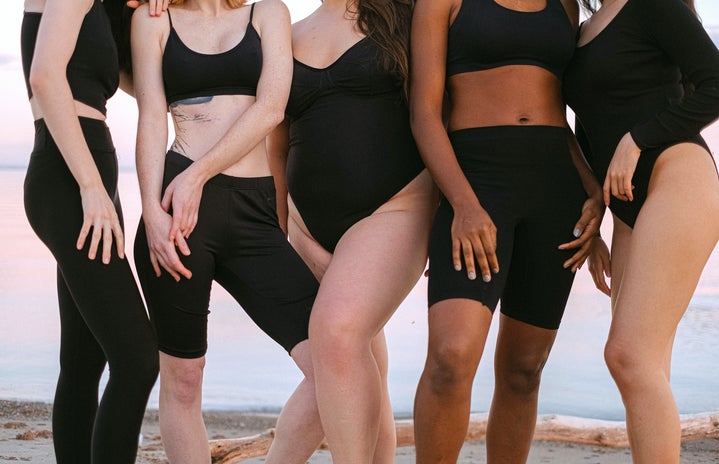Disclaimer: This article is an excerpt from an academic essay written by myself. as my intellectual property I am sharing this work on the Her Campus platform to highlight important issues of racism and fatphobia.
White Skin Sells
As Hennessey (1994: 32) argues, when any social movement becomes popular, it is immediately commodified by those looking to capitalise the movement and associate themselves with something seen as progressive in public discourse. As the body positivity movement has gained traction online and subsequently become one of the most popular social movements, it has been commodified and become a capitalist venture for many. This commodification has furthered harmed the body positive movement by centring White bodies while being marketed to the public. It is no surprise White bodies are centred considering they are the norm in marketing and advertising (Nicholson, 1998: 194) and are often the default representation in Western capitalism (McLaren, 1997: 5). As brands began to take notice of the body positivity movement, they began to enlist plus size individuals who in one way or another conformed to the pre-existing body ideals to market their brands as progressive. Thus, this bolsters their profits, without having to completely radicalise their institutions (Luck, 2016: 3). For example, highly influential fashion Magazine, Vogue – upon feeling the pressure to showcase a wider range of body types – enlisted Ashley Graham, known as the first plus-size supermodel, to be their fat representation. While Graham is marketed as plus size, wearing a US size 18, it is no coincidence she is White and also conforms to other societal bodily ideas, such as a slim face with a small nose and high cheekbones, as well as a relatively small waist and flat stomach. By using Graham, Vogue is able to publicly state they are inclusive to larger bodies, thus market themselves as a kind, progressive company (Lebovic, 2019: 111), without having to employ individuals who do not prescribe to pre-conceived notions of beauty. By doing so, they can raise their profits as the public buy into their new ‘progressive’ approach. This highlights that through the popularisation and subsequent commodification of the body positivity movement, larger White bodies are centred on a public stage for the profits of companies, all while the fat Black women who first organised the movement are excluded.
Not only does Graham conform to Eurocentric ideals, she is almost always the only plus size representation used by Vogue and other such publications (Limatius, 2020: 215), a phenomenon recognised by many fat Black activists. Fellow model, and self-described ‘fat Black Queer woman’ Ghanaian born Enam Asiama spoke in a 2019 interview about her journey to body acceptance and positivity and how her foray into modelling has changed her perspective on the modelling world. She states that, to many in the industry, she is not worthy of being a model or of being in front of a camera. She notes how people, and by extension, companies, are often not willing to bend the rules enough to cater to her and her body (Asiama, 2020). Moreover, when speaking about the abuses and injustices she faces daily, she states she is ‘picking and choosing to put on rose-tinted glasses’ and if she thinks about the abuse constantly, ‘she simply won’t live’ (Asiama, 2020). Comparing Asiama’s experience within the modelling world with that of Graham’s really highlights the commercial need to sell White skin, and the subsequent detrimental effects this has on Black women. While Graham does arguably represent some plus size women, Vogue’s repeated use of her Eurocentric body as a form of body-positive virtue signalling contrasted with Asiama’s struggles as a fat Black woman in the modelling industry highlights how the body positive movement is not representative of the women it was first envisioned for. What was once a radical acceptance movement has subsequently become an echo chamber of Whiteness, advocating for and uplifting the few ‘acceptable’ White voices via brands boosting profits and marketing themselves as progressive, all while the Black women who first needed the body positivity movement are left unrepresented.
The Angry Fat Black Woman
When a fat Black woman does make it into the body positive mainstream, the movement does not protect them from racism in the way its radical roots and activists like Bass and Tillmon would have demanded. For Black Women, currently making yourself visible within the body positivity movement opens you up to a wealth of stereotyping and racism not directed to their White counterparts. One of these racialised and highly damaging stereotypes is that of the ‘angry fat Black woman.’ As such, while being unapologetic in their bodies for a White woman may see them gain a mass of praise from within the body positivity movement, the same cannot be said for Black women. For these women, taking the same unabashed and unapologetic stance risks being interpreted through racialised stereotyping, casting them as sassy, arrogant and angry (Givens & Monahan, 2005: 89). Returning to the words of Black Body Positive activist Stephanie Yeboah, she recognises she is judged differently to White women for her unapologetic views stating she is ‘tired of the narrative of black fat women being ‘sassy’’ and wishes she could exist without feeling shame or the need to apologise for existing in her fat Black body (Barr, 2020). In a similar vein, Black Muslim Body Positive activist Leah Vernon spoke of the extra plight taken on by Black women in the current movement, in particular reference to the idea of living unapologetically. She states in her own autobiography that for Black women in the body positive movement living unapologetically is more about gaining the right to exist in peace, without racialised stereotyping, than it is about being able to wear the dress you are self-conscious about, or going out to eat in a nice restaurant without fear or being judged (Vernon, 2019: 33). She asserts she ‘won’t be apologising for my mere being. For being fat. For being Black. For being Muslim. [she has] said sorry enough by assimilating’ (Ibid: 130). Both Yeboah’s and Vernon’s testimony highlights that despite its roots planted by and enlarge for Black women, the current movement harbours damaging stereotypes about Black women, making it difficult for their voices to be heard. Therefore, the current body positivity movement is not representative of the women it was first created for.
Simply by existing in the mainstream, both Yeboah and Vernon challenge the body positivity movement’s own prejudices toward Black women, however both are likely to experience further negative stereotyping as they try to bring attention to these prejudices. They, and other Black women in the movement, are sometimes stereotyped as ‘killjoys’ for trying to bring their plight to light. As Ahmed (2010: 62) describes, those who seek to stand up for what they believe in and demand equality within social movements are often then typecast as ‘being in the way’ and ‘difficult’. For Vernon, she states she has experienced this treatment from other White body positive activists, stating that while she found it frustrating to not be listened to, it also renewed her reasoning for fighting for Black women’s rights within the body positivity movement itself (Saad, 2020). It is for this reason that Black Lives Matter activist Ashleigh Shackleford insists body positivity is simply White feminism (Shackleford, 2016), for it not only ignores race, but actively works to exclude Black women. This negative reaction to Black women, labelling them as killjoys, is indicative of a movement that is not representative. It highlights how entrenched racialised stereotypes have become in the movement and that White women’s bodies remain undisturbed as a body ideal, even for a movement supposedly disrupting normative beauty ideals. Thus, the current body positive movement is far removed from its radical roots first envisioned by Black fat activists, and therefore it is not currently representative of the Black women who created it.
References
Ahmed, S. (2010). The Promise of Happiness. (Durham: Duke University Press)
Asiama, E. (2020). ‘I’m Fat, Happy and Wear WTF I Want: Enam Asiama’ YouTube. [online] Available from:
Barr, S. (2020). ‘Stephanie Yeboah interview: ‘Reclaiming the word fat has taken away ammunition from trolls’ The Independent. [online] Available from:
Givens, S. M., Monahan, J.L. (2005). ‘Priming Mammies, Jezebels, and Other Controlling Images: An Examination of the Influence of Mediated Stereotypes on Perceptions of an African American Woman’, Media Psychology 7(1), 87–106.
Hennessey, R. (1994). ‘Queer visibility in commodity culture’ Cultural Critique, 29, 31–76.
Lebovic, A. (2019). ‘Refashioning Feminism: American Vogue, the Second Wave, and the Transition to Postfeminism. Journal of Women’s History, 31(1), 109-132
Limatius, H. (2020). ‘Fat Acceptance or Body Positivity? A Discourse-Based Investigation of Plus-Size Fashion Blogging and Social Movements. Movement and Change in Literature, Language, and Society, 211-232
Luck, E. (2016). ‘Commodity Feminism and its Body: The Appropriation and Capitalization of Body Positivity Through Advertising.’ Liberated Arts: a journal for undergraduate research, 2(1), 1-7
McLaren, P. (1997). ‘Decentering Whiteness.’ Multicultural Education, 5(1), 4-11.
Nicholson, D. (1998). ‘Developing a Media Literacy of Whiteness in Advertising’. White reign: Deploying whiteness in America, 193-212.
Shackleford, A. (2016). ‘#BodyPositiveWeek: body positivity doesn’t exist without Black Lives Matter.’ [online] Available from:


